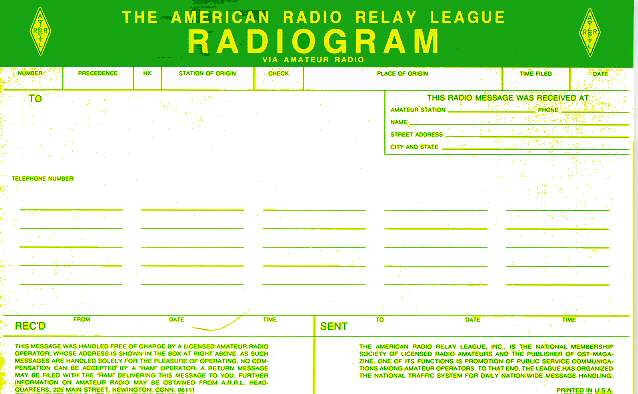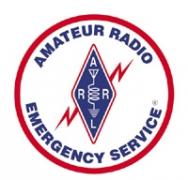Chapter 1: ARESChapter One: Amateur Radio Emergency Service ®(ARES ®)
The Amateur Radio Emergency Service ® (ARES ® ) consists of licensed amateurs who have voluntarily registered their qualifications and equipment for communications duty in the public service when disaster strikes. Every licensed amateur, regardless of membership in ARRL or any other local or national organization, is eligible to apply for membership in the ARES. Training may be required or desired to participate fully in ARES. Please inquire at the local level for specific information. Because ARES is an Amateur Radio service, only licensed radio amateurs are eligible for membership. The possession of emergency-powered equipment is desirable, but is not a requirement for membership.
1.1 ARES OrganizationThere are four levels of ARES organization--national, section, district and local. National emergency coordination at ARRL Headquarters is under the supervision of the ARRL Membership and Volunteer Programs Manager, who is responsible for advising all ARES officials regarding their problems, maintaining contact with federal government and other national officials concerned with amateur emergency communications potential, and in general with carrying out the League's policies regarding emergency communications. 1.2 Section LevelAt the section level, the Section Emergency Coordinator is appointed by the Section Manager (who is elected by the ARRL members in his or her section) and works under his/her supervision. In most sections, the SM delegates to the SEC the administration of the section emergency plan and the authority to appoint District and local ECs, Assistant SECs and Assistant DECs. Some of the ARRL sections with capable SECs are well-organized. A few have scarcely any organization at all. It depends almost entirely on who the section members have put into office as SM and whom he/she has appointed as SEC. 1.3 Local LevelIt is at the local level where most of the real emergency organizing gets accomplished, because this is the level at which most emergencies occur and the level at which ARES leaders make direct contact with the ARES member-volunteers and with officials of the agencies to be served. The local EC is therefore the key contact in the ARES. The EC is appointed by the SEC, usually on the recommendation of the DEC. Depending on how the SEC has set up the section for administrative purposes, the EC may have jurisdiction over a small community or a large city, an entire county or even a group of counties. Whatever jurisdiction is assigned, the EC is in charge of all ARES activities in his area, not just one interest group, one agency, one club or one band. 1.4 District LevelIn the large sections, the local groups could proliferate to the point where simply keeping track of them would be more than a full-time chore, not to mention the idea of trying to coordinate them in an actual emergency. To this end, SECs have the option of grouping their EC jurisdictions into logical units or "districts" and appointing a District EC to coordinate the activities of the local ECs in the district. In some cases, the districts may conform to the boundaries of governmental planning or emergency-operations districts, while in others they are simply based on repeater coverage or geographical boundaries. Figure 2 depicts the typical section ARES structure. 1.5 Assistant ECsSpecial-interest groups are headed up by Assistant Emergency Coordinators, designated by the EC to supervise activities of groups operating in certain bands, especially those groups which play an important role at the local level, but they may be designated in any manner the EC deems appropriate. 1.6 Planning CommitteeThese assistants, with the EC as chairman, constitute the local ARES planning committee and they meet together from time to time to discuss problems and plan projects to keep the ARES group active and well-trained. There are any number of different situations and circumstances that might confront an EC, and his/her ARES unit should be organized in anticipation of them. An EC for a small town might find that the licensed amateur group is so small that appointing assistants is unnecessary or undesirable. On the other hand, an EC for a large city may find that even his assistants need assistants and that sometimes it is necessary to set up a special sub-organization to handle it. There is no specific point at which organization ceases and operation commences. Both phases must be concurrent because a living organization is a changing one, and the operations of a changing organization must change with the organization. 1.7 Operation and FlexibilityWe have discussed how a typical ARES unit may be organized. Just what shape the plan in your locality will take depends on what your EC has to work with. He/she uses what he/she has, and leaves provision in the plan for what he/she hopes, wants and is trying to get. Flexibility is the keynote. The personnel, equipment and facilities available today may not be available tomorrow; conversely, what is lacking today may be available tomorrow. In any case, bear in mind that organizing and planning are not a one-person task. The EC is simply the leader, or, as the title indicates, the coordinator. His/her effectiveness inevitably will depend on what kind of a group he/she has to work with. Make yourself available to your EC as a member of his planning committee, or in any capacity for which you think you are qualified. Local ARES operation will usually take the form of nets -- HF nets, VHF (repeater) nets, even RTTY, packet or other special-mode nets, depending on need and resources available. Your EC should know where your particular interests lie, so that you can be worked in where your special talents will do the most good. It is not always possible to use the services of all ARES members. While it is general policy that no ARES member must belong to any particular club or organization to participate in the program, local practical considerations may be such that you cannot be used. This is a matter that has to be decided by your EC. In some cases, even personality conflicts can cause difficulties; for example, the EC may decide that he cannot work with a particular person, and that the local ARES would be better served by excluding that person. This is a judgment that the EC would have to make; while personality conflicts should be avoided, they do arise, more often than we would prefer. The EC on the job must take the responsibility for making such subjective evaluations, just as the SEC and DEC must evaluate the effectiveness of the job being done by the EC. 1.8 ARES Operation During Emergencies and DisastersOperation in an emergency net is little different from operation in any other net, requires preparation and training. This includes training in handling of written messages--that is, what is generally known as "traffic handling." Handling traffic is covered in detail in the ARRL Operating Manual. This is required reading for all ARES members--in fact, for all amateurs aspiring to participate in disaster communications. The specifications of an effective communication service depend on the nature of the information which must be communicated. Pre-disaster plans and arrangements for disaster communications include:
While much amateur-to-amateur communicating in an emergency is of a procedural or tactical nature, the real meat of communicating is formal written traffic for the record. Formal written traffic is important for:
When relays are likely to be involved, standard ARRL message format should be used. The record should show, wherever possible:
The address should be complete and include a telephone number if known. The text should be short and to the point, and the signature should contain not only the name of the person sending the message but his title or connection, if any. Point-to-point services for direct delivery of emergency and priority traffic do not involve relays. Indeed, the full ARRL format is often not needed to record written traffic. Shortened forms should be used to save time and effort. For example, the call sign of the originating station usually identifies the place of origin. Also, the addressee is usually known and close by at the receiving station, so full address and telephone number are often superfluous. In many cases, message blanks can be designed so that only key words, letters or numbers have to be filled in and communicated. In some cases, the message form also serves as a log of the operation. Not a net goes by that you don't hear an ARL Fifty or an ARL Sixty One. Unfortunately, "greetings by Amateur Radio" does not apply well during disaster situations. You may hear an ARL text being used for health and welfare traffic, but rarely during or after the actual disaster. Currently, no ARL text describes the wind speed and barometric pressure of a hurricane, medical terminology in a mass casualty incident or potassium iodide in a nuclear power plant drill. While no one is suggesting that an ARL text be developed for each and every situation, there is no reason why amateurs can't work with the local emergency management organizations and assist them with more efficient communications. Amateurs are often trained and skilled communicators. The emergency management community recognizes these two key words when talking about the Amateur Radio Service. Amateurs must use their skills to help the agencies provide the information that needs to be passed, while at the same time showing their talents as trained communicators who know how to pass information quickly and efficiently. We are expected to pass the information accurately, even if we do not understand the terminology. Traffic handlers and ARES members are resourceful individuals. Some have developed other forms or charts for passing information. Some hams involved with the SKYWARN program, for instance, go down a list and fill in the blanks, while others use grid squares to define a region. Regardless of the agency that we are working with, we must use our traffic-handling skills to the utmost advantage. Sure, ARL messages are beneficial when we are passing health and welfare traffic. But are they ready to be implemented in times of need in your community? The traffic handler, working through the local ARES organizations, must develop a working relationship with those organizations who handle health and welfare inquiries. Prior planning and personal contact are the keys to allowing an existing National Traffic System to be put to its best use. If we don't interface with the agencies we serve, the resources of the Amateur Radio Service will go untapped. Regardless of the format used, the appropriate procedures cannot be picked up solely by reading or studying. There is no substitute for actual practice. Your emergency net should practice regularly--much more often than it operates in a real or simulated emergency. Avoid complacency, the feeling that you will know how to operate when the time comes. You won't, unless you do it frequently, with other operators whose style of operating you get to know. |
